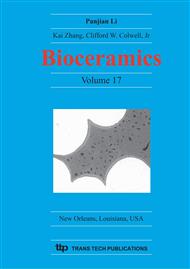p.341
p.345
p.349
p.353
p.357
p.361
p.365
p.369
p.373
Surface Modification of Calcium Hydroxyfluor Carbonate Apatites by Bisphosphonates
Abstract:
Hydroxyapatite has been frequently described as an osteoconductive but not osteoinductive material based on failure to observe bone formation in nonbony sites. Bisphosphonates (BPs) are stable pyrophosphate analogs, that enhance the proliferation, differentiation and bone forming activity of osteoblasts and are potent inhibitors of bone resorption. In this paper, the modification of a calcium hydroxyfluor carbonate apatite with sodium alendronate and (4-(aminomethyl)benzene)bisphosphonic acid is described. The surface modification is carried out by refluxing the apatite in a bisphosphonate acetone solution. Modified particles are characterized by thermal analysis, ATR-IR spectroscopy and contact angle between other techniques. A weight loss between 150 and 500°C can be observed for the modified apatites. IR spectra show the appearance of bisphosphonate bands on modified powders. The surface energy of the modified apatite is reduced up to a 74% from the total apatite value after the alendronate surface modification with a decrease of 58% of the polar component main responsible of the cellular interaction of biomaterials.
Info:
Periodical:
Pages:
357-360
Citation:
Online since:
April 2005
Keywords:
Price:
Сopyright:
© 2005 Trans Tech Publications Ltd. All Rights Reserved
Share:
Citation:


